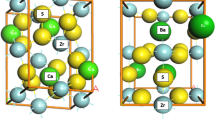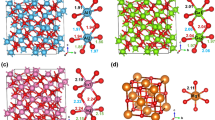Summary
The electronic properties of the semiconducting layer compounds GaS, GaSe and InSe are considered comparatively in a series of papers. In this first paper the band structures of the three compounds are computed by using the same method and the same approximations for all of them. The overlap-reduced semi-empirical tight-binding method (ORSTB) is outlined by first. The method consists in scaling only the overlap integrals in the secular equation. In this way it takes into account the localization of the atomiclike functions used in the Bloch sums in a more effective and simpler way than previous tight-binding semiempirical schemes. For GaS, GaSe and InSe bands only two scaling factors are used as matching parameters to reproduce optical and photoemission experimental bands is very good. In particular, the shape of the bonding metal-metal bands which all previous tight-binding calculations failed to reproduce is correctly obtained here. For all the three compounds the top of the valence bands falls at the point Γ and the bottom of the conduction bands is atM. The indirect gap is slightly lower than the direct one in GaSe and InSe, while it is larger in GaS, in agreement with the experiment. The remarkably similar overall shape of the bands, for all the compounds, stems from the similar magnitude of the two-centre integrals. The atomic eigenvalues and the crystal fields are responsible for the main differences in the widths of groups of bands in the three cases. The density of states is computed on the basis of the obtained bands, by using the tetrahedral linear approximation by Lehmann and Taut.
Riassunto
Si presenta il primo di una serie di lavori sulle proprietà elettroniche dei semiconduttori lamellari GaS, GaSe ed InSe. Si calcolano le strutture a bande di questi tre composti usando il medesimo metodo e le medesime approssimazioni. Si illustra il metodo «a legame stretto semiempirico a sovrapposizione ridotta» (ORSTB), che è basato su una riduzione solo degli integrali di sovrapposizione nell'equazione secolare. In tale modo si tiene conto della localizzazione delle funzioni di tipo atomico usate nelle somme di Bloch in modo efficace e più semplice di quanto fatto in precedenti schemi di calcolo semiempirici nell'approssimazione di legame stretto. Per calcolare le bande del GaS, GaSe ed InSe si sono usati solo due fattori di scala come parametri per riprodurre i dati sperimentali ottici e di fotoemissione. L'accordo tra le bande sperimentali e quelle calcolate è molto buono. In particolare, è riprodotta correttamente la forma delle bande leganti metallo-metallo, al contrario di tutti i calcoli fatti precedentemente nell'approssimazione di legame stretto. In tutti e tre i composti il massimo delle bande di valenza si trova al punto Γ ed il minimo di quelle di conduzione si trova adM. Il gap indiretto è di poco inferiore a quello diretto nel GaSe e nell'InSe, mentre lo è di più nel GaS, in accordo con l'esperienza. La somiglianza della forma delle bande dei tre composti deriva dal fatto che gli integrali a due centri nei tre composti sono di valore paragonabile. In tutti e tre i casi si è trovato che le principali differenze nella larghezza di gruppi di bande sono dovute alle differenze negli autovalori atomici e nei campi cristallini. Si calcola inoltre la densità degli stati sulla base delle bande ottenute.
Similar content being viewed by others
References
A. Segura, J. N. Besson, A. Chevy andM. S. Martin:Nuovo Cimento,38 B, 345 (1977).
N. Romeo:Riv. Nuovo Cimento,3, 103 (1973).
B. L. Evans:Physics and Chemistry of Materials with Layered Structures, Vol.4 (Dordrecht, 1977), and references quoted therein.
M. Schlüter, J. Camassel, S. Kohn, J. P. Voitchovsky, Y. R. Shen andM. L. Chen:Phys. Rev. B,13, 3534 (1976).
G. Ottaviani, C. Canali, F. Nava, Ph. Schmid, E. Mooser, R. Minder andI. Zschokke:Sol. State Comm.,14, 933 (1974).
J. M. Thomas, I. Adams, R. H. Williams andM. Barber:Trans. Faraday Soc.,68, 755 (1972);I. Adams, J. M. Thomas, M. Barber andM. Williams:Chem. Phys. Lett.,10, 297 (1971).
F. R. Shepherd andP. M. Williams:Phys. Rev. B,12, 5705 (1975).
R. H. Williams, P. C. Kemeny andL. Ley:Sol. State Comm.,19, 495 (1976).
G. Margaritondo, J. E. Rowe andS. B. Christman:Phys. Rev. B,15, 3844 (1977).
A. Balzarotti, R. Girlanda, V. Grasso, E. Doni, F. Antonangeli andM. Piacentini:Can. Journ. Phys.,56, 700 (1978).
F. Bassani andG. Pastori Parravicini:Nuovo Cimento,50 B, 95 (1967).
M. Schlüter:Nuovo Cimento,13 B, 313 (1973).
H. Kamimura andK. Nakao:Journ. Phys. Soc. Japan,24, 1313 (1968).
J. V. McCanny andR. B. Murray:J. Phys. C,10, 1211 (1977).
S. Nagel, A. Baldereschi andK. Maschke: to be published.
A. Bourdon:J. Physique Suppl.,35, C 3–261 (1974).
Y. Depeursinge:Nuovo Cimento,38 B, 153 (1977).
A. Balzarotti, R. Girlanda, V. Grasso, E. Doni, F. Antonangeli, M. Piacentini andA. Baldereschi:Sol. State Comm.,24, 327 (1977).
Y. Depeursinge, E. Doni, R. Girlanda, A. Baldereschi andK. Maschke:Sol. State Comm.,27, 1449 (1978).
A. Bourdon, A. Chevy andJ. Besson:XIV International Conference on the Physics of Semiconductors (Edinburgh, 1978).
P. Thiry, Y. Petroff, R. Pinchaux, C. Guillot, Y. Ballu, J. Lecante, J. Paignè andF. Levy:Sol. State Comm.,22, 685 (1977).
P. K. Larsen, G. Margaritondo, J. E. Rowe, M. Schlüter andN. V. Smith:Phys. Lett.,58 A, 423 (1976);I. T. McGovern, A. Parke andR. M. Williams: Daresbury Report (1977).
K. Larsen, S. Chiang andN. V. Smith:Phys. Rev. B,15, 3200 (1977).
T. L. Gilbert: inMolecular Orbitals in Chemistry Physics and Biology, edited byP. O. Löwdin andB. Pullman (New York, N. Y., 1964), p. 405.
See ref. (11). An equivalent approach consists in contracting the free-atom wave functions to obtain the scaled overlap and interaction integrals. Such a method has been employed successfully in several compounds and recently applied byNagel et al. (ref. (15)S. Nagel, A. Baldereschi andK. Maschke: to be published.) to GaSe. These authors multiply the atomic wave functions with Gaussians and utilize the widths of them as free parameters.
P. W. Anderson:Phys. Rev.,181, 25 (1969). See alsoD. W. Bullet:J. Phys. C,8, 2695 (1975).
R. W. G. Wyckoff:Crystal Structure, Vol.1 (New York, N. Y., 1963).
A. Kuhn, A. Chevy andR. Chevalier:Acta Crystallog.,32 B, 983 (1976).
A. Kuhn, A. Chevy andR. Chevalier:Phys. Stat. Sol.,31 A, 469 (1975).
A. Likforman, D. Carre, J. Etienne andB. Bachet:Acta Crystallog.,31 B, 1252 (1975).
A. Baldereschi, K. Maschke andM. Schlüter:Helv. Phys. Acta 47, 434 (1974).
J. C. Slater andG. F. Koster:Phys. Rev.,94, 1498 (1954).
E. Doni: to be published.
F. Herman andS. Skillman:Atomic Structure Calculations (Englewood Cliffs, N. J., 1963).
E. Clementi andD. L. Raimondi:Journ. Chem. Phys.,38, 2686 (1963);E. Clementi, D. L. Raimondi andW. P. Reinhardt:Journ. Chem. Phys.,47, 1300 (1967).
J. C. Slater:Phys. Rev.,81, 385 (1951).
J. E. Robinson, F. Bassani, S. R. Knox andJ. R. Schrieffer:Phys. Rev. Lett.,9, 521 (1962).
E. Clementi andC. Roetti:At. Data and Nucl. Data Tables,14, 177 (1974).
G. Lehmann andM. Taut:Phys. Stat. Sol.,54 b, 469 (1972).
A. Balzarotti, R. Girlanda, V. Grasso, P. Perillo, E. Doni andM. Piacentini:Lett. Nuovo Cimento,21, 49 (1978).
E. Aulich, J. L. Brebner andE. Mooser:Phys. Stat. Sol.,31, 129 (1969).
J. L. Brebner andG. Fischer:Can. Journ. Phys.,41, 561 (1963).
M. V. Andriyashik, M. Yu. Sakhnovskii, V. B. Timofeev andA. D. Yakimova:Phys. Stat. Sol.,28, 277 (1968).
V. L. Bakumenko, Z. D. Kovalyuk, L. N. Kurbatov andV. F. Chinshko:Sov. Phys. Semicond.,10, 621, 740 (1976).
See alsoM. Piacentini andC. G. Olson:V International Conference on Vacuum Ultraviolet Radiation Physics (Montpellier, 1977).
E. U. Condon andG. H. Shortley:The Theory of Atomic Spectra (Cambridge, Mass., 1953), p. 122.
Author information
Authors and Affiliations
Rights and permissions
About this article
Cite this article
Doni, E., Girlanda, R., Grasso, V. et al. Electronic properties of the III–VI layer compounds GaS, GaSe and InSe. I: Band structure. Nuov Cim B 51, 154–180 (1979). https://doi.org/10.1007/BF02743704
Received:
Published:
Issue Date:
DOI: https://doi.org/10.1007/BF02743704




